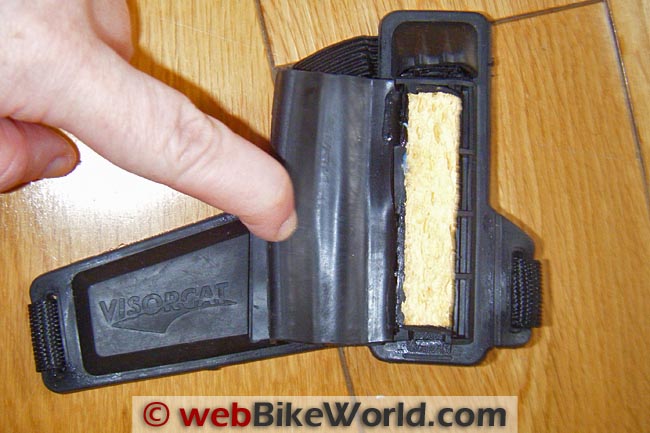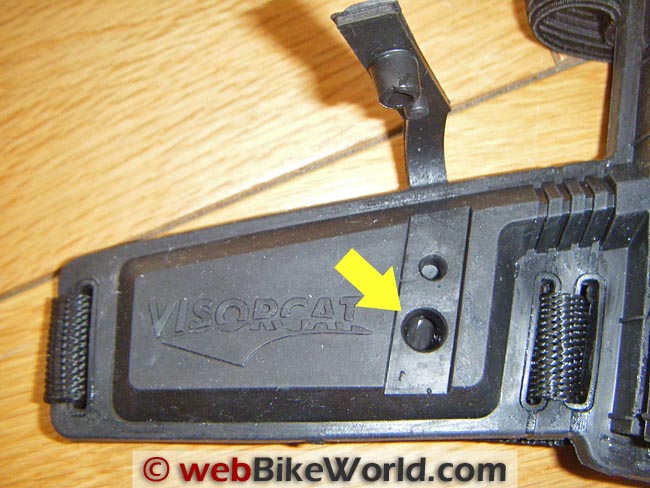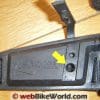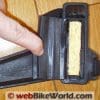The Visorcat is a motorcycle helmet visor cleaning system.
It includes both a replaceable sponge and a wiper blade and a reservoir to hold cleaning fluid.
The Visorcat attaches to the left hand with an adjustable nylon wrist strap.
It feels awkward at first, but I quickly became used to it.
Combining the instantaneous action of a wiper blade with the deeper cleaning of a sponge accessory, the Visorcat works effectively.
It is also transferable between gloves, and it’s always to hand (see what I did there?).
It’s probably the most expensive visor cleaning accessory I’ve ever seen, but it is built to last.
It’s also made in Britain by a small startup, so the price may come down as the enterprise takes off.
Dirty or water-splashed visors are an annoyance at the best of times, and the restricted vision they impose can even be dangerous, especially at night.
Methods of dealing with the problem include wiping the visor with a glove while riding. But this can make the problem worse by smearing the water, bird deposit or bug guts around.
Stopping to perform a more thorough job with a stored cloth or sponge works also, but isn’t the optimal solution.
Some gloves come with a rubber wiper built in and aftermarket wipers that slide on to the finger or thumb are also available.
Now there’s another option in the shape of the Visorcat, which cleans as well as wipes and is designed to be used on the move.
When I saw that the product was designed by a small, independent company, manufactured in the UK, and endorsed by the Institute of Advanced Motorists as a safety device, I placed an order.
Visorcat: Appearance and Setup
My Visorcat arrived within a few days. £30 seems a high price point for a visor cleaner — you could buy a cheap pair of gloves for that — but this is a new product being produced by a small firm in, presumably, small quantities. It’s also a fairly complicated piece of kit.
The main body of the Visorcat is made of rubber and consists of a wiper and a fluid reservoir.
It’s designed to lie along the inside edge of a thumb or forefinger, and there’s a loop of black elastic to secure it.
The wiper section has a rubber flap with one long and two short blades; pass it across your visor one way (Editor’s Note: I hope while stopped at a stop sign, red light, etc.) and the flap is pushed back, revealing a sponge which treats your visor to a scrub with cleaning fluid.
Wipe the other way and the flap snaps back into place, squeegeeing water and dirt away with the blades.
An adjustable nylon strap with plastic fastener holds the Visorcat to the wearer’s wrist, keeping it in place for riding while allowing the glove to be taken off without removing the device. All this weighs 65 grams in total.
As well as the Visorcat itself, the package contained a 50 ml bottle of cleaning fluid and a page of printed instructions. I read through these carefully before attempting to fill the reservoir.
Unfortunately, although the instructions were very specific with regards to the “filler cap” and “dummy cap”, I wasn’t sure which hole was which.
I undid the small upper cap on the bottle, inserted the nozzle in the larger hole, squeezed…and ended up with cleaning fluid all over my hands and the floor. I’m not sure how much went into the Visorcat, but when I pressed the sponge it remained bone dry.
I emailed Visorcat for clearer instructions, received a prompt response, and on my second attempt I managed to fill the reservoir properly using the larger, lower hole. Time to put on the Visorcat and test it when the opportunity arose.
I was confident I wouldn’t have to wait long for some rain.
Riding With the Visorcat
The weather this year in the UK has been so dismal that I was still wearing my winter Hein Gericke Pathan two-finger gloves (review) by the time “summer” nominally arrived. I didn’t have to wait long for a suitably rainy morning, picking my journey to work one gloomy day for the trial run.
Once kitted up, left glove on but right glove off, I slid the Visorcat over my left hand and slipped the elastic loop around my thumb.
As soon as I started to turn my bike around in the yard, I realised that the Visorcat was too long for my thumb and would get in the way when I tried to operate the horn or indicators.
The manufacturer suggests using the forefinger instead, so I tried this. Because I was wearing two-finger gloves, the device felt a little tight, but the configuration seemed fine and I was confident to set off.
I was very conscious at first of the extra weight and the slight restriction against my knuckle.
This made me sceptical of claims that the Visorcat could be left on at all times, but I soon stopped noticing it.
On my low-speed journey through steady urban rain, I used the wiper every few minutes.
If I looked directly at the Visorcat, I could see that it was working as claimed: first the sponge wiped from left to right across my vision, then the rubber blades from right to left, all accompanied by a very authentic squeaky squeegee noise.
I did notice that it was the side of the sponge doing the wiping, rather than the top, but it performed very well at clearing the visor.
The warmer weather eventually arrived and I switched to lighter gloves. Now I could fit the elastic over one finger.
With this configuration, the Visorcat hit against the cable from my heated handlebar grip; this is down to the way I hold the bars, so if you do something similar you may have to adjust your grip slightly.
Hand size and handlebar configuration will definitely affect how comfortable you feel using the Visorcat, and how much or how little you notice it on the move. If you have slim wrists, you will also have a fair amount of strap left over after fastening the Visorcat on, and you may wish to trim this down.
Note that Visorcat advises that the strap is “best left on the long side so that the strap can easily be loosened, leaving the Visorcat attached to the glove. If it’s trimmed too much, this would not be possible.
We therefore recommend that excess strap is tucked behind itself”.
A long weekend in France gave me the opportunity to try out the device while riding at some speed in the rain, and also to pit it against some French insects, which always seem bigger, gooier and more numerous than their British cousins.
The dual action sponge and rubber proved much more effective at removing bug guts than a rubber wiper or glove finger alone, although it sometimes took more than one application to achieve 100% clearance.
I don’t use the Visorcat every time I go out. I probably should, as dust and smears do build up, but it only tends to see action when something splatters across my visor. Thus the sponge tends to dry out between uses and take a few wipes to get going again.
A couple of presses before I set off would solve the problem, if I ever remembered.


Care of the Visorcat
This isn’t a throwaway device, and it has been designed with long-term use in mind. The sponge can be slid out of its groove for cleaning, or, should it become irrevocably grubby or tatty, a replacement pack of three is available from Visorcat.
Ingredients for the fluid aren’t listed, by the way, but it’s blue and smells like washing-up liquid (Visorcat said that the cleaning fluid is a “well-known brand of visor cleaning fluid and contains only mild detergents suitable for cleaning helmets and visors”.
50 ml and 250 ml replacement bottles of the cleaning fluid are available from the product website. Visorcat don’t endorse any alternative products, but do suggest plain water as another option.
The availability of replacement sponges and the fact that the device can be transferred between gloves means that the Visorcat should last a long time, which helps to offset the £30 price tag.
My worry is that the elastic loop will break or lost its elasticity long before the main body wears out, although this should be a simple part to replace with a spot of DIY.
Conclusion
Combining the instantaneous action of a wiper blade with the deeper cleaning of a sponge accessory, the Visorcat works effectively, is transferable between gloves, and it’s always to hand (see what I did there?).
It’s probably the most expensive visor cleaning accessory I’ve ever seen, but it is built to last. It’s also made in Britain by a small startup, so the price may come down as the enterprise takes off.
It’s certainly an effective cleaning aid but I’m not as convinced of the safety advantages as the IAM.
After all, your hand is off the bars and in front of your eyes for twice as long as it would be if you simply wiped your visor with your glove. Used with caution at appropriate times, however, the Visorcat does a good job of keeping vision clear.
By removing dirt before it dries and hardens, this nifty little gadget also makes it a lot easier to give your visor a thorough clean when you get home.
When I first tried the Visorcat I didn’t think I’d be leaving it on my glove permanently, but now I’ve got used to wearing and using it, I’m allowing it to stay put.
More wBW: Anti-Fog Treatment Reviews | V2 Sponge Review | Helmet Reviews
| webBikeWorld Review: Visorcat Helmet Visor Cleaner | |
|---|---|
| Manufacturer: Visorcat (UK) | List Price: £30 |
| Colors: Black. | Made In: UK |
| Review Date: August 2013 | |
Owner Comments and Feedback
See details on submitting comments.
From “S” (September 2013): “Thank you for the review. I have a question: have you tried securing the Visorcat to your wrist, over the jacket cuff rather than on your hand? It looks as if that might work and, if you are willing / did try it, how did it work out?
have small hands and the Visorcat looks like it may overwhelm my comfort factor while gripping my (heated) grips.”
Alice’s Reply: I tried the Visorcat on my jacket sleeve today but it didn’t really work for me, both because wiping the visor with a finger or back of glove is a more natural action.
With the Visorcat installed over the wrist, I have to lift my arm a lot higher to wipe and because there’s nothing to secure the finger loop, the Visorcat was only fastened to my jacket at one side and was loose at the top. Doesn’t work this way.
From “S.S.” (September 2013): “At first, I thought you had accidentally printed one of your April Fool’s “reviews” early.
Cleaning your visor should improve your safety margin, but trying to do so while on the move seems unnecessarily dangerous to me.
I clean my visor at every gas and rest stop, using a microfiber towel and a spray bottle of eyeglass cleaner.
Cheap and easy, and does make my riding safer.
Editor’s Reply: Not sure the Visorcat was meant to use when riding, but probably comes in handy at a stop sign, red light, or on the side of the road.
I wouldn’t suggest using it while riding in traffic or at high speeds; use good judgment before cleaning a visor or face shield.
I can think of many times when my face shield was splattered with bugs and if I had a Visorcat, it would be an easy matter to quickly pull over and clean up or to wait for the next stop sign to do it.
The Visorcat seems quicker and easier than taking off the gloves and fishing a bottle of cleaner and a sponge out of my pocket or from the saddlebags, top box, tank bag or under the seat.
Alice’s Reply: I do quite a lot of visor-wiping (both with the Visorcat and with the back of my glove) while I’m on the move, so it didn’t even occur to me!













